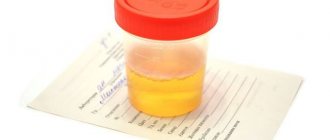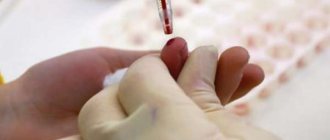Cystitis is a common inflammatory disease of the bladder among the adult population, especially in women. Acute cystitis can become chronic with periodic exacerbations. The reasons for frequent exacerbations of cystitis in women are a short, wide urethra (urethra) and proximity to natural sources of infection - the vagina and anus. Hormonal disorders in women often lead to vaginal dysbiosis and the growth of pathogenic bacteria, which provoke frequent exacerbations of bladder inflammation. In men, symptoms of cystitis are usually associated with prostate disease.
Main symptoms of cystitis
- frequent painful urination
- pain in the groin area
- false urge to urinate
- cloudy urine, possibly containing blood
- sudden onset of symptoms
- increase in body temperature
Classification
Depending on the number of bacteria, some experts conditionally distinguish minor and severe bacteriuria. In clinical practice, only one classification is used to determine the patient’s treatment tactics:
- Asymptomatic bacteriuria.
It is characterized by the detection of bacteria in the urine in the absence of any complaints and other laboratory signs of urinary system infections (leukocyturia, etc.) in the patient. - Symptomatic bacteriuria.
A combination of clinical symptoms and identification of bacteria in a urine sample.
Causes of bacteriuria
Violation of preparation for analysis
A fairly common cause of bacteriuria. Improper preparation for a urine test, especially failure or careless toileting of the external genitalia, can lead to false positive results. It is also considered incorrect to take a urine test during menstruation. Blood, being a breeding ground for bacteria, creates a favorable environment for their reproduction.
When using non-sterile containers to collect urine, the sample may be contaminated with foreign flora. To submit urine to a bacteriological laboratory for culture, it is recommended to use special tubes with preservatives (boric acid, formate and sodium borate) that stabilize the bacterial composition of urine.
Asymptomatic bacteriuria
Detection of bacterial flora in the urine without clinical and laboratory signs of infectious and inflammatory diseases UVP occurs in 1-5% of healthy premenopausal women, in 2-10% of pregnant women, in 4-20% of healthy elderly men and women. In young healthy men, asymptomatic bacteriuria is almost never observed.
Such age-sex characteristics of bacteriuria are associated with the anatomical and physiological characteristics of the female urogenital system, changes in hormonal levels during pregnancy and menopause, as well as age-related changes in local immunity. Asymptomatic bacteriuria is a benign condition and does not require any intervention, except in some patients at high risk for developing UTI infection.
Bacteriuria
Urinary tract infections
The most common cause of bacteriuria is acute, chronic and recurrent forms of urinary tract infections. The causative agents of these pathologies are mainly gram-negative enterobacteria - Escherichia coli, Klebsiella, Proteus. Very rarely, infections of the genitourinary system are caused by gram-positive flora - staphylococci, enterococci. Infection occurs in several ways. The most common is the ascending route - through the urethra to the bladder and/or kidneys.
Less commonly, a hematogenous or lymphogenous route is possible. This option occurs when there is an additional source of infection in the body - pneumonia, infections of the oral cavity, ENT organs. The degree of bacteriuria can be different; it does not correlate with the severity of the disease and disappears almost from the first days of treatment with properly selected antibacterial drugs.
- Pyelonephritis.
This is an infectious inflammation of the renal collecting system involving interstitial tissue. It develops mainly in young women (5-6 times more often than in men). - Cystitis.
Inflammation of the mucous membrane of the bladder. A single episode of cystitis occurs in half of women worldwide. - Nonspecific urethritis.
Inflammation of the urethra, on the contrary, is more common in men due to a longer and narrower urethra.
Genital infections
Bacteriuria in infections of male and female genital organs is very rare. They are caused by nonspecific opportunistic gram-negative and gram-positive flora (Escherichia coli, enterococci, anaerobic bacteria) and often occur together with cystitis and urethritis. The severity of bacteriuria is in no way related to the intensity of the inflammatory process.
- Infections of the male genital area.
These include bacterial prostatitis (occupies about 10% of all cases of inflammation of the prostate gland), and extremely rarely, orchitis and epididymitis (inflammation of the testicle and its epididymis), balanoposthitis (inflammation of the head and foreskin of the penis). - Infections of the female genital area.
These infections include inflammation of the vagina and/or vulva (vaginitis, vulvovaginitis), and cervix (cervicitis).
It is worth noting that in the case of infectious diseases of the genital organs caused by bacteria that provoke sexually transmitted diseases, such as chlamydia, mycoplasmosis, gonorrhea, bacteriuria does not develop. These infections are diagnosed by other special research methods.
Risk factors for bacteriuria
This group includes diseases or conditions that contribute to the appearance of microorganisms in the urine:
- Glucosuria
: poorly controlled hyperglycemia in diabetes mellitus, long-term use of glucocorticosteroids, various endocrine disorders (Cushing's disease/syndrome, pheochromocytoma, glucagonoma). - Previous UTIs
. - Impaired urine outflow
: urolithiasis, congenital anomalies of the structure of the urinary system, ureteral stenosis. - Reverse reflux of urine
: vesico-ureteropelvic reflux. - Presence of an installed urinary catheter
. - Shift in urine pH to the alkaline side
: dietary habits, medications.
How to properly collect a urine test for cystitis
The average portion of urine during the first morning urination is collected in a sterile container (the first and last portions are flushed into the toilet).
Urine collection is possible at any time during the day with prior agreement with the attending physician.
When collecting urine, it is advisable not to touch the container to your body.
Before urinating, women need to spread their labia with their fingers so that foreign impurities do not get into the urine from the skin of the external genitalia.
The volume of urine for testing should be ¾ of the volume of the container. The minimum volume of urine for testing is 30 ml.
It is advisable to deliver the container with urine to the medical office within 2 hours after collecting the biomaterial.
Diagnostics
There are several diagnostic methods for detecting bacteriuria. Proper preparation required before taking the test. In a specific clinical situation, the attending physician selects a specific study or a combination of methods:
- Microscopy.
Detection of bacteria by direct microscopic examination of centrifuged urine sediment. The method has extremely low diagnostic value. Microscopy may reveal signs of improper patient preparation - an abundance of diverse flora, a large amount of mucus and squamous epithelial cells. - Nitrite test.
During their life, bacteria that colonize the genitourinary tract convert nitrates from food into nitrites. Urine test strips have a special reagent zone that stains in the presence of nitrites. The test may be false negative if there are no nitrates in the patient’s diet, infection with bacteria that do not form nitrites (streptococci), or high levels of ascorbic acid in the urine. - Bacteriological culture.
This method is considered the gold standard for diagnosing bacteriuria. In the laboratory, a urine sample is cultured with culture media for specific bacteria. To confirm the diagnosis of asymptomatic bacteriuria, at least 2 cultures are required with an interval of 24 hours. The disadvantage of this method is the long waiting time for results - 2 or 3 days. - Flow cytometry.
Some modern automatic analyzers are capable of performing a detailed assessment of the cellular composition of a urine sample, including counting the number of bacteria.
Microscopy, nitrite test and flow cytometry are considered indicative methods for detecting bacteriuria, and microbiological culture is a confirmatory method. An important point is that in the case of bacterial growth reaching a clinically significant titer (above 10x5 colony-forming units per ml) during culture, sensitivity to antibacterial drugs must be determined. This is necessary for selecting therapy.
In addition to detecting bacteriuria, additional studies are required to differentiate the etiology of its occurrence:
- Analysis of urine.
TAM indicators help to determine the cause of bacteriuria. For example, the presence of leukocytes and an alkaline urine reaction highly likely excludes asymptomatic bacteriuria; an increase in protein content and red blood cells may indicate pyelonephritis. Detection of transitional epithelial cells by microscopy indicates damage to the bladder or urethra, and renal epithelium and a large number of cylinders indicate damage to the kidneys. - Ultrasound.
Ultrasound of the kidneys with pyelonephritis shows an expansion of the ventricular region, and abnormalities in the structure of the ureters can also be detected. With prostatitis, ultrasound of the prostate gland reveals an increase in its size and a decrease in echogenicity. With epididymitis, ultrasound of the testicle visualizes enlargement of the epididymis and diffuse changes. - Examination by a gynecologist.
If you suspect a gynecological disease, you need to consult a gynecologist who examines the genital organs, bimanual vaginal examination, and colposcopy. If necessary, a smear is taken from the mucous membranes or secretions for cultural examination. - Examination by a urologist.
Similarly, if indicated, men are scheduled to consult a urologist for a digital rectal examination, collection of prostatic fluid or ejaculate.
Culture of urine on nutrient media
Chemical properties
Protein. Normally there should not be any of it in the urine, or there should be very little of it - less than 0.002 g/l. Sometimes it does appear in healthy people - for example, if they ate meat, or experienced serious physical activity or emotional stress the day before - but if a person stops eating meat, rests and calms down, protein secretion stops. If it continues to be excreted in the urine (this is determined by repeating the test again and again), it may be due to inflammation of the kidneys or urinary tract.
Glucose. Healthy non-pregnant people should not have glucose in their urine. As we have already written, “sugar” enters the urine during glucose metabolism disorders, for example, in type II diabetes.
Ketone bodies. These substances accumulate in the body if the body does not have enough carbohydrates and is forced to destroy fat reserves to obtain energy. Since it is not normal for us to eat them, ketone bodies should not be present in the urine of healthy non-pregnant people. As a rule, ketone bodies appear in the urine of fasting people or due to heavy physical exertion, but most often against the background of uncontrolled type 1 diabetes.
Bilirubin. Healthy, non-pregnant people should not have bilirubin in their urine. As we have already written, bilirubin enters the urine if the liver cannot cope with its utilization. This happens with hepatitis and when the outflow of bile is disrupted - this can happen if the bile ducts, for example, are blocked by a gallstone.
Urobilinogen. This is a colorless product of the “neutralization” of harmful bilirubin by the liver and intestinal bacteria. Up to 10 mg/l of urobilinogen is excreted in the urine. If the level of this substance is high, there is a high probability that the person has liver problems - from viral hepatitis to liver failure. But it is possible that the issue is the accelerated breakdown of hemoglobin - this happens, for example, with hemolytic anemia and some other diseases.
Nitrites. Together with urine, the body gets rid of nitrogen compounds - nitrates, so healthy people always have them in it. But if pathogenic bacteria settle in the urinary tract - for example, E. coli, Enterobacteriaceae or Klebsiella - nitrites appear in the urine. The fact is that these bacteria feed on nitrates and convert them into nitrites, so the presence of these substances in the urine is always a bad sign. However, the absence of nitrites does not mean the absence of infection. Some staphylococci and streptococci are indifferent to nitrates, so they have to be identified by examining urine under a microscope.
Correction
If bacteriuria is detected, you must consult a doctor for correction. Asymptomatic bacteriuria in the vast majority of cases does not require treatment. The exceptions are pregnant women, patients with installed urinary catheters, patients with poorly controlled diabetes mellitus - these patients are indicated for antibacterial therapy. For symptomatic bacteriuria, the following treatment is recommended:
- Pyelonephritis
. First-line drugs are pecinillins (amoxicillin/quavulanate), cephalosporins (cefixime, ceftibuten). For strains that are resistant to them, they resort to fluoroquinolones (levofloxacin, ciprofloxacin), new generation cephalosporins (cefepime). - Cystitis
. Fosfomycin trometamol or nitrofurans (nitrofurantoin, furazolidone) are used. For recurrent cystitis, medications based on cranberry extract, D-mannose, and herbal remedies (canephron) are prescribed. Also, for relapses, some experts recommend lyophilisate of bacterial lysate of Escherichia coli. - Genital tract infections
. For prostatitis and epididymitis, fluoroquinolones and macrolides (azithromycin) are used; for vulvovaginitis, cervicitis, instillations of antiseptic solutions and antibiotics active against anaerobic flora (metronidazole, clindamycin) are used.
Forecast
Bacteriuria in itself cannot serve as a predictor of clinical outcome. The prognosis is directly determined by the underlying disease - the most favorable for asymptomatic bacteriuria, cystitis, urethritis. Frequently occurring pyelonephritis contributes to the formation of kidney stones. With severe bilateral pyelonephritis, serious life-threatening complications can develop - carbuncle, kidney abscess, hydronephrosis. An extremely rare and most fatal consequence of pyelonephritis is urosepsis.
A few words about the urinary system of a healthy person
Urine, which is one of the waste products of our body, is formed and accumulated in the organs of the urinary system. Urine is produced in the kidneys and passes down the ureters to the bladder. The bladder serves as a reservoir for storing urine, which is then emptied through the urethra. The urethra ends at the penis in men and the area above the vagina in women.
The kidneys are a pair of fist-sized organs located in the lumbar region that serve as a filter for the body, removing waste products from the blood in the form of urine. The kidneys also regulate the balance of various chemicals in the body (sodium, potassium, calcium, phosphorus, etc.) and control the acidity of the blood. The kidneys produce several hormones that help regulate blood pressure, stimulate the production of red blood cells, and promote the development of strong bones.
The ureters are two muscular tubes that transport urine to the bladder.
Normal urine is sterile and free of bacteria. However, bacteria can enter the urine from the urethra and then travel to the bladder.








